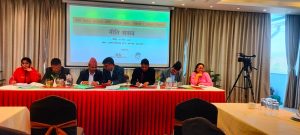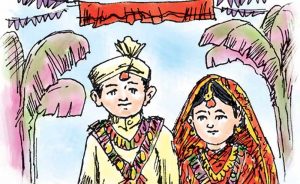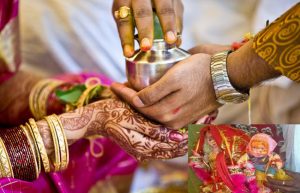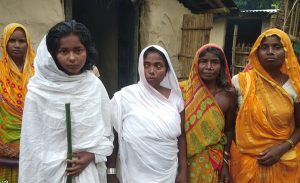
On a mid-July Monday, Sanita Tamang, lying on bed number 257 at the maternity home in Thapathali, is a silent witness to the severe repercussions of child marriage. Beside her sits her mother-in-law, Shakuntala, wrapped in a sombre demeanour. Sanita, a 16-year-old mother, recently delivered her son through a C-section on June 27.
When the doctor asks Sanita how she is feeling, she does not respond; instead, she lowers her head. Her husband, Sushil Pakhrin, answers, that she had a little thin soup today. Sanita, a 16-year-old new mother, gave birth to a son via surgery on June 28 in Jugal Rural Municipality-2, Sindhupalchok.
While asking questions, she remains silent. Her husband jokes that she might be shy because of the presence of the doctors.
Eloped while in 8th grade
Sanita was 15 years old and studying in grade 8 when she eloped. Three months after marriage, she became pregnant. Sushil explains that they had not considered family planning at that time, leading to her unplanned pregnancy.
Sushil, 20, lives near Sanita’s maternal home. Sanita’s mother had remarried and moved to Jugal Rural Municipality 13 years ago, taking Sanita and her younger siblings with her. Sanita and Sushil met while Sanita was in 7th grade and began seeing each other frequently. After marriage, she had only one menstrual period before becoming pregnant. Sushil, who had failed the SEE (Secondary Education Examinations) exams two years ago, now works as a labourer in the village to support the family.
Sanita’s pregnancy was confirmed at a local health institution. After going into labour at home, her husband took her to the local health centre. When normal delivery was not possible, they were referred to the maternity hospital. Sushil shares the challenges they faced with her young age and labour pains, stating that she has been in a daze for two days and has not eaten well.
Another teenage mother
Neha Gharti, 18, also struggles with motherhood. Attempting to breastfeed her daughter from bed number 53 at the maternity hospital, she expresses her concerns about not producing enough milk. Neha met Kiran Gharti, her husband on social media. Uncertain whether their families would accept their relationship, they eloped.
She was in 9th grade when she fell ill and had to discontinue her studies. Her pregnancy was confirmed when she visited the health centre after experiencing abdominal and back pain.
Neha regrets her hasty marriage and early pregnancy, wishing she had waited a few more years. They have been living in a rented room in Kathmandu for the past six months, with Kiran working for a private company.
14 per cent of teenage girls are pregnant
Sanita and Neha represent the many young girls who become pregnant in Nepal, even though marriage under the age of 20 is illegal. Despite this, statistics from the Paropakar Maternity and Women’s Hospital (Prasuti Griha) show that approximately 1,800 deliveries annually involve girls under 19. According to the 2022 Nepal Demographic and Health Survey, 14 per cent of girls aged 15-19 are pregnant, which translates to about 206,000 young mothers based on the 2078 BS national census.
Dr Kirtipal Subedi, a senior obstetrician and gynaecologist, attributes early marriages and pregnancies to factors such as lack of education, poverty, social practices, and unemployment. Dr Madhusudan Subedi, a medical sociologist at Patan Academy of Health Sciences, emphasises that traditional thinking persists, with some communities still believing in early marriage for daughters.
Dr Subedi notes, “There is still a mentality that daughters should be married off early because their mothers and grandmothers were married early.”
Karnali and Madhesh: The highest rates
According to the Nepal Demographic and Health Survey (NDHS), Karnali Province has the highest rate of teenage pregnancies. The survey shows that 21 per cent of girls aged 15-19 in Karnali are pregnant. Similarly, this figure is 20 per cent in Madhesh Province. In Gandaki, Koshi, and Sudurpaschim, the rate is 13 per cent each, while Lumbini has 10 per cent, and Bagmati has 8 per cent.
Dr Bivek Kumar Lal, head of the Family Welfare Division under the Department of Health Services, believes that social factors significantly influence these alarming statistics. He emphasises the need to investigate the reasons behind early marriages and pregnancies.
Factors such as family conditions pushing for early marriage, school-age marriages, dropping out of school, and not continuing education after becoming pregnant all contribute to this social issue. Dr Lal says, “Adolescence is an age where physical and mental maturity is gradually attained. Since these girls are not ready to become mothers, it has long-term physical and mental impacts.”
The statistics on child marriage are also alarming. About 3 per cent of girls and 1 per cent of boys get married before the age of 15. The survey reveals that 2 per cent of boys and girls have had sexual intercourse by the age of 15 or around that age. Additionally, one-third of girls engage in sexual activities by the age of 18.
Increased pregnancies among uneducated girls
Comparing the 1996 NDHS data with the present, the number of teenage pregnancies in Nepal has decreased. The percentage of pregnancies among girls under 20 was 23.9 per cent in 1996. After 26 years, this figure dropped by 10 per cent to 13.6 per cent in 2022. However, among uneducated girls, the percentage of pregnancies has increased. In 1996, 31.8 per cent of uneducated girls aged 15-19 were pregnant, which rose to 32.7 per cent by 2022.
In 2001, the pregnancy rate among uneducated girls was 31.5 per cent, which increased to 32.7 per cent in 2006. This rate then slightly decreased to 31.6 per cent in 2011 but rose again to 32.6 per cent in 2016, as per NDHS data. Dr Subedi, a medical sociologist, mentions that a study conducted among the Chepang community in Makwanpur showed that most girls were married before the age of 19. He notes that girls who lack a conducive environment for education, come from economically weak families, and do not receive love from their parents are more likely to elope and marry early.
Dr Shree Prasad Adhikari, director of Paropakar Maternity and Women’s Hospital, mentions that Nepali society still harbours the misconception that keeping daughters unmarried past the age of 20 leads to elopement and a loss of family honour. Due to patriarchal thinking, families pressure their daughters to marry at a young age. An analysis by “Heard International” of NDHS data shows that the problem of teenage pregnancies is particularly prevalent among Muslim and Dalit communities. According to the 2022 NDHS data, 22 per cent of teenage pregnancies are among Muslim girls.
After the Muslim community, Dalits have the highest rates of early marriage, with 20.7 per cent of Dalit girls getting pregnant early. The primary reasons for early marriage among Muslim and Dalit communities are poverty and lack of education. The Madheshi community follows with 13.5 per cent, indigenous groups with 12.9 per cent, and the Chhetri-Bahun (Brahmin) community with 7.8 per cent. Dr Subedi states, “The tradition of early marriage is particularly rampant in the Brahmin community of the economically prosperous Terai region, leading to many divorces.”
In Nuwakot’s Kakani Rural Municipality Ward No. 1, a 17-year-old girl has already had two children. Most girls in this area have more than one child by the age of 20, according to Damodar Khanal, in charge of Okharpauwa Health Post. When asked why early marriages occur, Khanal explains, “It’s a common practice here. Family pressure and plans, as well as mutual affection leading to elopement, contribute to early marriages.”
Health impacts, sexual and labour exploitation
Child marriage and early pregnancies have direct negative impacts on a girl’s health. Dr Subedi, a gynaecologist, explains, “Girls who marry early often have children within a few years. Some even get pregnant right after their first menstruation.” Due to the incomplete physical and mental maturity of teenage girls, neither the mother nor the child is healthy. Early pregnancies increase the risk of miscarriages, mental health issues, and physical complications. “If there is no family support and the girl undergoes prolonged suffering, it can lead to depression,” says Dr Subedi.
The bones and joints of teenage mothers are not fully developed, and the uterus is small, leading to high risks during childbirth. The chances of maternal mortality are high, and babies born to teenage mothers are often underweight and malnourished due to a lack of knowledge about balanced nutrition. According to doctors, the average weight of a newborn in Nepal is 3 kg, but babies born to young mothers weigh between 1.5 kg and 2 kg, leading to physical and mental disabilities.
The 2022 NDHS data shows that 9 per cent of married girls aged 15-19 face pressure from their families. Their participation in sexual and health-related decisions is minimal, with only 37 per cent of girls in this age group participating. Additionally, 21 per cent of girls experience sexual abuse from their husbands or boyfriends.
Dr Lal emphasises, “Adolescents are at risk and face challenges that we have not fully understood. We have failed to provide adequate sexual and reproductive health information and counselling, and we need to improve adolescent-friendly services.”
Early pregnancies also result in girls spending more time on household chores than earning an income during their working years. Their education is disrupted, and they become financially dependent on their families during pregnancy. Medical sociologist Dr Subedi notes that although the law sets the minimum marriage age at 20, societal practices diverge. He argues for creating an environment where teenagers do not drop out of school to prevent child marriage.
Samila Dahal Paudel, head of the Family Planning and Reproductive Health Branch under the Department of Health Services, stresses the importance of raising awareness about safe sexual practices. “If we can provide timely information about where to get and how to use family planning methods, this problem can be reduced to some extent,” she says.
Dr Adhikari adds that the government has much work to do to end the issues of child marriage and early pregnancies. “It’s time for all of us to think. Legally, technically, and practically, we advocate for the age of 20,” he says, “but we have not been able to prevent child marriage. It is essential to address the social aspects.”

























